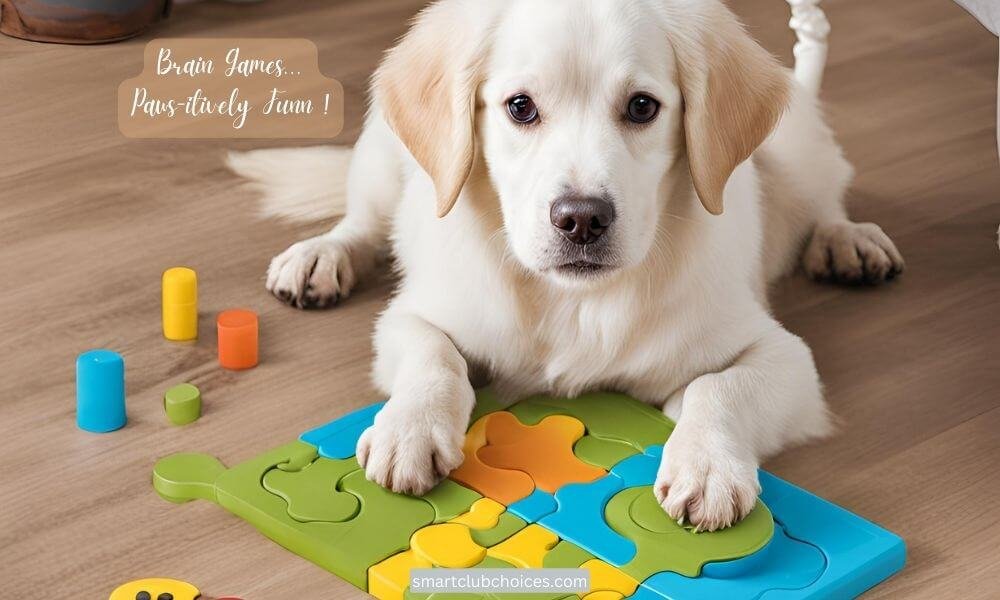Interactive Puzzles for Your Dog: Keeping Your Dog’s Brain Active and Healthy
If you’re a dog owner, you probably know how important mental and physical exercise is for your furry companion. While walks and playtime offer great physical outlets, your dog also needs mental stimulation to stay happy and healthy. Just like humans, dogs can get bored, and when they do, they may develop unwanted behaviors such as excessive barking, chewing on furniture, or even anxiety. Enter dog interactive puzzles, a fantastic tool for engaging your dog’s mind and providing them with hours of enrichment.
In this comprehensive guide, we’ll explore the benefits of dog puzzles, the different types available, how to choose the right puzzle for your dog, and provide an overview of some of the best dog puzzle toys on the market.
Table of Contents
(1) Why Your Dog Needs Interactive Puzzles
Interactive puzzles are designed to challenge your dog’s brain and keep them mentally engaged. They can come in various forms, such as treat-dispensing toys, hide-and-seek games, or logic-based puzzles that require problem-solving skills. Let’s dive into the key benefits of dog puzzles and why every dog owner should consider adding them to their pet’s routine.
- Mental Stimulation
Dogs are naturally curious and intelligent animals that need more than just physical exercise to stay happy. Without mental stimulation, they can become bored, which may lead to destructive behaviors. Puzzles force your dog to use their brain to solve a challenge, such as finding hidden treats or unlocking compartments, giving them something to focus on and keeping their mind sharp.
- Reduces Boredom and Anxiety
Just like humans, dogs can suffer from boredom, especially if left alone for long periods of time. This can lead to anxiety and behaviors like excessive barking or chewing. Interactive puzzles provide a productive way for your dog to pass the time, reducing stress and anxiety by keeping their minds occupied and engaged.
- Encourages Natural Instincts
Interactive puzzles tap into your dog’s natural instincts to forage, hunt, and problem-solve. Dogs love working for rewards, and puzzle toys are a great way to encourage them to use their noses, paws, and brains to find hidden treats or solve a puzzle, mimicking behaviors they would use in the wild.
- Promotes Slow Eating
Some puzzle toys are specifically designed to dispense food or treats, making them an excellent option for dogs that eat too quickly. Slow-feeder puzzles force your dog to work for their food, which can help prevent bloating and digestive issues. Plus, it adds an extra layer of mental stimulation to mealtime.
- Builds Confidence
Solving puzzles can boost your dog’s confidence by allowing them to achieve small victories. When your dog successfully solves a puzzle and gets a reward, they experience a sense of accomplishment. This can be especially beneficial for shy or timid dogs who need a confidence boost.
- Fun and Engaging Bonding Activity
While many interactive puzzles are designed for solo play, they can also be used as a fun way to bond with your dog. You can guide your dog through the puzzle, encourage them as they solve it, and celebrate their success together. This can strengthen your bond while providing enrichment.
(2) Types of Dog Interactive Puzzles
Not all interactive puzzles are the same. They come in a variety of designs and difficulty levels, so you can find one that best suits your dog’s needs, size, and intelligence level. Here are the main types of dog puzzles available.
- Treat-Dispensing Toys
Treat-dispensing puzzles are among the most popular types of interactive dog toys. These puzzles usually involve your dog having to figure out how to release treats or kibble from the toy. They may need to roll the toy, move parts, or solve a simple puzzle to access their reward.
- Best For: Dogs that love food and enjoy problem-solving.
- Example: KONG Classic – A hollow rubber toy that can be filled with treats or peanut butter.
- Puzzle Boards
Puzzle boards feature compartments, sliders, or hidden chambers that your dog has to unlock or move to reveal hidden treats. These puzzles come in different levels of difficulty, with some requiring multiple steps to get the reward.
- Best For: Dogs that enjoy using their paws and noses to search for hidden rewards.
- Example: Outward Hound Dog Brick Puzzle – A popular board puzzle where dogs have to slide and flip lids to uncover treats.
- Interactive Plush Toys
Interactive plush toys often come with small hidden toys or treats inside them. These toys mimic a game of hide-and-seek, where your dog has to dig, pull, or chew to retrieve the hidden toys. They’re often less about problem-solving and more about satisfying your dog’s foraging and hunting instincts.
- Best For: Dogs that love soft toys and digging.
- Example: ZippyPaws Burrow Squeaky Hide and Seek Toy – A plush toy that hides squeaky characters inside for your dog to discover.
- Slow-Feeder Puzzles
Designed to encourage slower eating, these puzzles are great for dogs that tend to gulp down their food too quickly. Slow-feeder puzzles feature ridges, compartments, or mazes that make it more challenging for your dog to access their food.
- Best For: Dogs that eat too fast or suffer from digestive issues.
- Example: Outward Hound Fun Feeder Slo-Bowl – A food bowl with ridges and patterns that slow down your dog’s eating.
- Electronic Puzzle Toys
For high-tech dog owners, electronic puzzle toys add an extra layer of difficulty and engagement. These puzzles may feature lights, sounds, or automatic movement that keep your dog on their toes, challenging them to solve a puzzle in a dynamic way.
- Best For: Tech-savvy pet owners and dogs that enjoy more complex, interactive play.
- Example: CleverPet Hub – An interactive pet game console that uses lights and sounds to challenge your dog’s brain.
(3) How to Choose the Right Puzzle for Your Dog
When selecting a puzzle for your dog, there are a few important factors to consider to ensure the puzzle is both safe and enjoyable for your pet.
- Size and Breed
Choose a puzzle that’s appropriate for your dog’s size and breed. A puzzle designed for a small dog may be too easy or not durable enough for a large breed, while a puzzle that’s too big could be frustrating for a small dog to manipulate. Always check the manufacturer’s recommendations for size and breed suitability.
- Difficulty Level
Interactive puzzles come in varying levels of difficulty, from beginner to expert. If your dog is new to puzzles, start with a simple one to build their confidence. As they get more experienced, you can increase the difficulty by choosing more complex puzzles that require multiple steps to solve.
- Easy puzzles: Great for beginners or young puppies.
- Intermediate puzzles: Perfect for dogs that have mastered basic puzzles.
- Advanced puzzles: Best for experienced puzzle-solvers or highly intelligent breeds.
- Material and Durability
Some dogs can be heavy chewers, so it’s important to choose a puzzle made from durable materials that can withstand some rough play. Look for puzzles made from non-toxic materials that are safe for your dog to chew on, and avoid puzzles with small parts that could be a choking hazard.
- Cleanability
Puzzles that involve treats or food can get messy, so it’s important to choose toys that are easy to clean. Many puzzles are dishwasher safe, while others may require hand washing. Make sure to check the cleaning instructions before purchasing.
- Your Dog’s Preferences
Every dog is different, and some may prefer certain types of puzzles over others. If your dog loves to dig or forage, a plush hide-and-seek toy may be more appealing. If they’re food-motivated, treat-dispensing puzzles will likely be a hit. It may take some trial and error to figure out which puzzles your dog enjoys the most.
(4) Training Your Dog to Use Interactive Puzzles
Some dogs will naturally take to puzzle toys, while others may need a little guidance. Here are some tips for helping your dog get the most out of their interactive puzzles:
- Start Slow
If your dog is new to puzzles, start with a simple one that has an easy-to-find reward. Show your dog how the puzzle works by demonstrating how to move or manipulate the parts to release the treat. Gradually increase the difficulty as your dog becomes more confident.
- Use High-Value Treats
Encourage your dog to engage with the puzzle by using high-value treats that they love. The more rewarding the prize, the more motivated your dog will be to solve the puzzle. As they get better at solving puzzles, you can switch to kibble or lower-value treats.
- Praise and Reward
Whenever your dog successfully solves a puzzle, give them plenty of praise and positive reinforcement. This will help build their confidence and motivate them to continue engaging with the puzzles.
- Supervise Playtime
While interactive puzzles are designed for solo play, it’s a good idea to supervise your dog, especially when they’re using a new toy. This ensures that your dog is using the puzzle correctly and safely, and you can intervene if they become frustrated or if the toy becomes damaged.
(5) Top Dog Interactive Puzzles
With so many interactive puzzles on the market, it can be hard to know where to start. Here’s a roundup of some of the best interactive puzzles available today, categorized by type and difficulty level.
- KONG Classic (Treat-Dispensing Toy)
The KONG Classic is a timeless toy that can be stuffed with treats, peanut butter, or kibble. Its durable rubber design makes it ideal for heavy chewers, and it’s available in various sizes to suit any breed.
- Difficulty Level: Beginner
- Best For: Chewers, food-motivated dogs
- Outward Hound Dog Brick Puzzle (Puzzle Board)
This popular puzzle board features sliding and flip compartments where you can hide treats. It offers a moderate level of difficulty and encourages your dog to use their paws and nose to find the rewards.
- Difficulty Level: Intermediate
- Best For: Puzzlers, dogs who love problem-solving
- ZippyPaws Burrow Squeaky Hide and Seek Toy (Interactive Plush)
The ZippyPaws Burrow toy mimics a hide-and-seek game, with squeaky characters hidden inside a plush burrow. Your dog will enjoy digging them out, satisfying their hunting and foraging instincts.
- Difficulty Level: Easy
- Best For: Dogs that love plush toys and foraging
- CleverPet Hub (Electronic Puzzle)
For tech-savvy pet owners, the CleverPet Hub offers a high-tech puzzle experience with lights and sounds. Your dog has to press the right buttons to unlock treats, offering an advanced level of mental stimulation.
- Difficulty Level: Advanced
- Best For: Tech-loving pet owners, intelligent dogs
(6) Conclusion
Dog interactive puzzles are more than just toys—they are essential tools for keeping your dog mentally stimulated, engaged, and happy. With so many different types and difficulty levels available, there’s a puzzle out there for every dog. Whether your dog is new to puzzles or a seasoned pro, these toys can provide hours of entertainment and enrichment, reducing boredom, anxiety, and destructive behavior.
By incorporating interactive puzzles into your dog’s daily routine, you’re helping to improve their overall well-being while offering a fun and rewarding way to bond. Start with simple puzzles, gradually increase the difficulty, and watch your dog thrive both mentally and physically.








